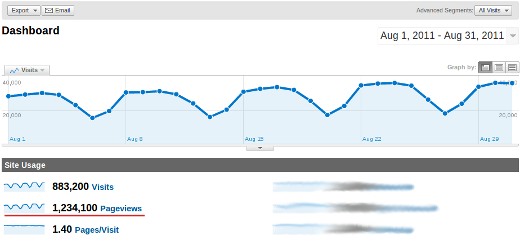
Some time ago one of my sites crossed
the one million monthly page views mark. The screenshot from Google Analytics
for the month of August is below.
While I know there are thousands of
other websites out there with much higher traffic, reaching this milestone made
me quite happy, as this is a website I built from scratch (i.e., I still
remember when I registered the domain).
Below you’ll find the eight most
important lessons I learned while building this site (I won’t reveal the URL
for privacy reasons, but the useful stuff is below anyway ):
1. Choose Your Niche Wisely
Most people who read this blog
probably think it is my largest and most profitable website. Well, it’s not.
The reason? Niches like blogging, make money online, SEO or Internet marketing
are pretty small when compared with mainstream stuff like gadgets, movies and
television, cars, health and so on. That is why my “money” sites are placed in
those niches, while I write on Daily Blog Tips mostly because I have fun doing
it.
2. Find A Unique Angle
While picking the right, relatively
large niche is important, I wouldn’t recommend you to start yet another tech or
cars blog, where you would get most of your content from other, larger blogs
and sites. Most mainstream niches are crowded, and if you just write about what
everyone else is writing, after them, people will have no reason to visit your
site. The solution? You need to find a unique angle. You need to come up with
an idea that will differentiate both your site and your content from others in
the same niche. Not easy, but possible.
3. Repeat Visitors Matter
There’s one metric that very few
people pay attention to, yet I believe it’s one of the best indicators of the
potential of a website: repeat visitors. Basically if the amount of repeat
visitors on your site is increasing over time it means that you are converting
some of your casual visitors into loyal ones, and that your overall traffic
will increase overtime. If the amount of repeat visitors is not growing, on the
other hand, it means that your content is failing to engage visitors to the
point that they will remember your site a couple of days after visiting it. In
this case you need to rethink your strategy.
4. Quality Over Quantity
If you need to choose between quality
and quantity, go with quality. In order words, you’ll get much better results
publishing one top quality article per week than publishing five average ones.
It’s the quality of your content that will increase the amount of repeat
visitors you get, after all, and the amount of backlinks you’ll receive from
other sites (more on that below).
5. Google Is Your Friend
Whether you like it or not, Google is
the main traffic driver around the web, so you better befriend it and use its
help to grow your site. This means that you need to understand how search
engines work (e.g., how Google crawls the web, how it decides which websites to
serve when people search for stuff, etc.) in order to optimize your content,
pages, and to promote your articles in a way that will increase their exposure
with search engines. It will take some effort from your end, but the results
are certainly worth it.
6. Research and Gather Data
When it comes to Search Engine
Optimization and to promoting your website in general, you’ll need to research
and gather data (as opposed to trusting your gut or intuition). That is, you’ll
need to understand what are the hot topics inside your niche, what search terms
are sending you more traffic, what visitors are more likely to stay on your
site and so on. With the numbers on your hand you’ll be able to make much
better decisions, both in terms of content and promotion.
7. You Can’t Do It Alone
While there are many people who manage
to grow large sites alone, I found that getting some help along the way made
all the difference. On most sites I have these days I focus exclusively on the
strategy/promotion aspects, while leaving the web design/content development to
other people. Sure, you’ll need to spend some money, but this is one of the
most efficient ways to grow any website (and any business, for the matter).
8. Slow and Steady Wins the Race
It took me around three years to go
from zero to one million monthly page views. During that time frame there was
no single event that catapulted my site’s popularity, no large spike in
traffic. It was a gradual and slow process, where every month I would promote
the site a bit more, do some guest posts and so on. All that mattered to me was
to see the traffic numbers increasing, albeit slowly, month after month.


